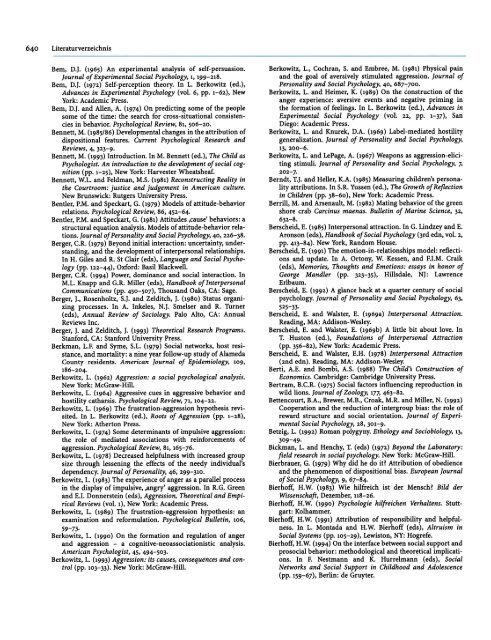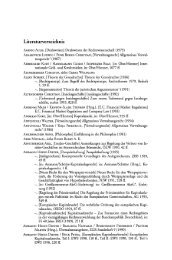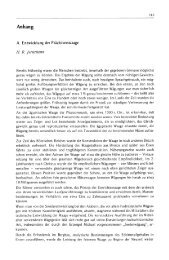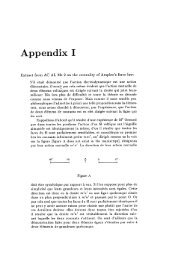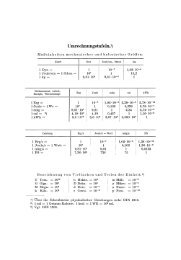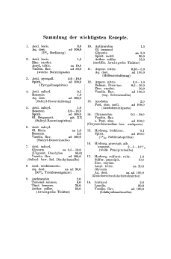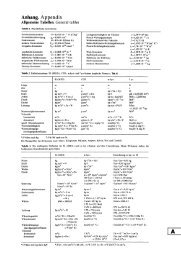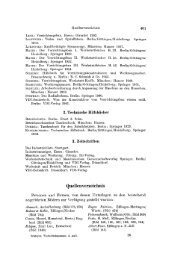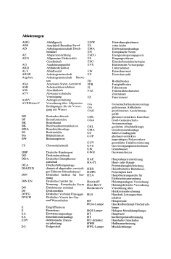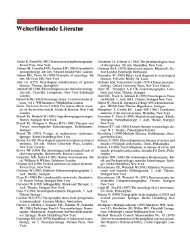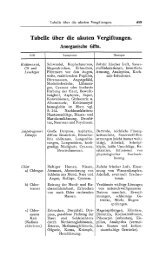Literaturverzeichnis 639Bargh, J.A. and Thein, R.D. (1985) Individual construct accessibility,person memory, and the recall-judgement link. The caseof information overload. Journal of Personality and SocialPsychology, 49, 1129-46.Barker, R.G. (1987) Prospecting in environmental psychology:OskaIoosa revisited. In D. Stokols and I. Altman (eds), Handbookof Environmental Psychology (vol. 2, pp. 1413-32), Chichester:John Wiley.Barker, R.G. and Schoggen, P. (1973) Qualities of Community Life.London: Jossey-Bass.Baron, R.A. (1970) Anonymity, de-individuation and aggression.Unpublished doctoral dissertation, University of Minnesota.Baron, R.A. (1971) Exposure to an aggressive model and apparentprobability of retaliation as determinants of adult aggressivebehavior. Journal of Experimental Social Psychology, 7, 343-55.Baron, R.A. (1977) Human Aggression. New York: Plenum Press.Baron, R.A. (1987) Effects of negative ions on interpersonalattraction: evidence for intensification. Journal of Personalityand Social Psychology, 52, 547-53.Baron, R.A., Baron, P.H. and Miller, N. (1973) The relationbetween distraction and persuasion. Psychological Bulletin,80,310-23.Baron, R.A. and Bell, P.A. (1975) Aggression and heat: mediatingeffects of prior provocation and exposure to an aggressivemodel. Journal of Personality and Social Psychology, 31,825-32.Baron, R.A. and Bell, P.A. (1976) Aggression and heat: theinfluence of ambient temperature, negative affect, and a coolingdrink on physical aggression. Journal of Personality andSocial Psychology, 33, 245-55.Baron, R.A. and Richardson, D.R. (1994) Human Aggression, 2ndedn. New York: Plenum.Baron, R.S., Cutrona, C.E., Hicklin, D., Russell, D. W. and Lubaroff,D.M. (1990) Social support and immune function amongspouses of cancer patients. Journal of Personality and SocialPsychology, 59, 344-52.Baron, R.S., Kerr, N.L. and Miller, N. (1993) Group Process, GroupDecision, Group Action. Milton Keynes: Open UniversityPress.Baroni, M.R. and Axia, G. (1989) Children's meta-pragmatic abilitiesand the identification of polite and impolite requests. FirstLanguage, 9, 285-97.Barrett, M., Harris, M. and Chasin, J. (1991) Early lexical developmentand maternal speech: a comparison of children's initialand subsequent uses of words. Journal of Child Language, 18,21-40.Barrett, M. and Short, J. (1992) Images of European people in agroup of 5-10 year old English school children. British Journalof Developmental Psychology, 10, 339-63.Barrows, S. (1981) Distorting Mirrors: visions of the crowd in thelate nineteenth century France. New Haven: Yale UniversityPress.Barsalou, L.W. (1985) Ideals, central tendency, and frequency ofinstantiation as determinants of graded structure in categories.Journal of Experimental Psychology: Learning, Memory,and Cognition, 11, 629-54.Barsalou, L.W. (1991) Deriving categories to achieve goals. In Posner(ed.), The Psychology of Learning and Motivation (vol. 27,pp. 1-64), New York: Academic Press.Bar-Tal, D., Nadler, A. and Blechman, N. (1980) The relationshipbetween Israeli children's helping behaviour and their perceptionof parents' socialisation practices. Journal of Social Psychology,lll, 159-67.Bartlett, F. (1932) Remembering - A study in experimental socialpsychology. Cambridge: Cambridge University Press.Bass, B.M. (1965) A Program of Exercises in Management andOrganizational Psychology. Pittsburgh: Management DevelopmentAssociates.Bass, B.M. (1985) Leadership and Performance Expectations. NewYork: Free Press.Bateman, A.J. (1948) Intra-sexual selection in Drosophila. Heredity,2, 349-68.Bates, E. (1979) The Emergence of Symbols. New York: AcademicPress.Batson, C.D. (1983) Sociobiology and the role of religion in promotingprosocial behaviour: an alternative view. Journal ofPersonality and Social Psychology, 45, 1380-5.Batson, C.D. (1987) Prosocial motivation: is it ever truly altruistic?In L. Berkowitz (ed.), Advances in Experimental SocialPsychology (vol. 20, pp. 65-122), San Diego, CA: AcademicPress.Batson, C.D., Batson, J.G., Griffit, C.A., Barrientos, S., Brandt, J.R.,Sprengelmeyer, P. and Bayly, M.J. (1989) Negative state reliefand the empathy-altruism hypothesis. Journal of Personalityand Social Psychology, 56, 922-33.Batson, C.D., Duncan, B.D., Ackerman, P., Buckley, P. and Birch,K. (1981) Is empathic emotion a source of altruisticmotivation? Journal of Personality and Social Psychology, 40,290-302.Batson, C.D., Dyck, J.L., Brandt, J.R., Batson, J.G., Powell, A.L.,McMaster, M.R. and Griffit, C. (1988) Five studies testingnew egoistic alternatives to the empathy-altruism hypothesis.Journal of Personality and Social Psychology, 55, 52-77-Baucom, D.H., Sayers, S.L. and Duhe, A. (1989) Attributional styleand attributional patterns among married couples. Journal ofPersonality and Social Psychology, 56, 596-607.Baxter, L.A. (1983) Relationship disengagement: an examinationof the reversal hypothesis. Western Journal of Speech Communication,47, 85-98.Baxter, L.A. (1985) Accomplishing relationship disengagement. InS. Duck and D. Perlmann (eds), Understanding Personal Relationships(pp. 243-65), Beverly Hills, CA: Sage.Baxter, L.A. and Wilmot, W.M. (1985) Taboo topics in dose relationships.Journal of Social and Personal Relationships, 2,253-69·Beale, D.A. and Manstead, A.S.R. (1991) Predicting mothers'intentions to limit frequency of infants' sugar intake: testingthe theory of planned behavior. Journal of Applied SocialPsychology, 21, 409-31.Beauvois, J.-L. (1984) La psychologie quotidienne. Paris: PressesUniversitaires de France.Beauvois, J.-L. and Joule, R.Y. (in press) Dissonance and Rationalization.Hemel Hempstead: Harvester Wheatsheaf.Beck, A.T., Rush, A.J., Shaw, B.F. and Emery, G. (1979) CognitiveTherapy of Depression. New York: Wiley.Beckmann, J. and Mattenklott, A. (1985) Theorien zur sozialenUrteilsbildung. In D. Frey and M. Irle (eds), Theorien derSozialpsychologie (vol. 3, pp. 211-37), Bern: Huber.Bell, P.A. and Baron. R.A. (1976) Aggression and heat: the mediatingrole of negative affect. Journal of Applied Social Psychology,6, 18-30.Bellezza, F.S. and Bower, G.H. (1981) Person stereotypes andmemory for people. Journal of Personality and Social Psychology,41, 856-65.Belli, R.F. (1989) Influences of misleading postevent information:misinformation, interference and acceptance. Journal of ExperimentalPsychology: General, 118, 72-85.Bellis, M.A. and Baker, R.R. (1990) Do females promote spermcompetition? Data for humans. Animal Behaviour, 40, 997-9.
640 LiteraturverzeichnisBem, D.J. (1965) An experimental analysis of self-persuasion.Journal of Experimental Social Psychology, 1, 199-218.Bem, D.J. (1972) Self-perception theory. In L. Berkowitz (ed.),Advances in Experimental Psychology (vol. 6, pp. 1-62), NewYork: Academic Press.Bem, D.J. and Allen, A. (1974) On predicting some of the peoplesome of the time: the search for cross-situational consistendesin behavior. Psychological Review, 81, 506-20.Bennett, M. (1985186) Developmental changes in the attributio!l ofdispositional features. Current Psychological Research andReviews, 4, 323-9.Bennett, M. (1993) Introduction. In M. Bennett (ed.), The Child asPsychologist. An introduction to the development of social cognition(pp. 1-25), New York: Harvester Wheatsheaf.Bennett, W.L. and Feldman, M.S. (1981) Reconstructing Reality inthe Courtroom: justice and judgement in American culture.New Brunswick: Rutgers University Press.BentIer, P.M. and Speckart, G. (1979) Models of attitude-behaviorrelations. Psychological Review, 86, 452-64.BentIer, P.M. and Speckart, G. (1981) Attitudes ,cause' behaviors: astructural equation analysis. Models of attitude-behavior relations.Journal of Personality and Social Psychology, 40, 226-38.Berger, C.R. (1979) Beyond initial interaction: uncertainty, understanding,and the development of interpersonal relationships.In H. Giles and R. St Clair (eds), Language and Social Psychology(pp. 122-44), Oxford: Basil Blackwell.Berger, C.R. (1994) Power, dominance and sodal interaction. InM.L. Knapp and G.R. Miller (eds), Handbook oflnterpersonalCommunications (pp. 450-507), Thousand Oaks, CA: Sage.Berger, J., Rosenholtz, S.J. and Zelditch, J. (1980) Status organizingprocesses. In A. Inkeles, N.J. Smelser and R. Turner(eds), Annual Review of Sociology. Palo Alto, CA: AnnualReviews Inc.Berger, J. and Zelditch, J. (1993) Theoretical Research Programs.Stanford, CA: Stanford University Press.Berkman, L.F. and Syme, S.L. (1979) Sodal networks, host resistance,and mortality: a nine year follow-up study of AlamedaCounty residents. American Journal of Epidemiology, 109,186-204.Berkowitz, L. (1962) Aggression: a social psychological analysis.New York: McGraw-Hill.Berkowitz, L. (1964) Aggressive cues in aggressive behavior andhostility catharsis. Psychological Review, 71, 104-22.Berkowitz, L. (1969) The frustration-aggression hypothesis revisited.In L. Berkowitz (ed.), Roots of Aggression (pp. 1-28),New York: Atherton Press.Berkowitz, L. (1974) Some determinants of impulsive aggression:the role of mediated assodations with reinforcements ofaggression. Psychological Review, 81, 165-76.Berkowitz, L. (1978) Decreased helpfulness with increased groupsize through lessening the effects of the needy individual'sdependency. Journal of Personality, 46, 299-310.Berkowitz, L. (1983) The experience of anger as a parallel processin the display of impulsive, ,angry' aggression. In R.G. Greenand E.I. Donnerstein (eds), Aggression, Theoretical and EmpiricalReviews (vol. 1), New York: Academic Press.Berkowitz, L. (1989) The frustration-aggression hypothesis: anexamination and reformulation. Psychological Bulletin, 106,59-73-Berkowitz, L. (1990) On the formation and regulation of angerand aggression - a cognitive-neoassociationistic analysis.American Psychologist, 45, 494-503.Berkowitz, L. (1993) Aggression: its causes, consequences and control(pp. 103-33). New York: McGraw-Hill.Berkowitz, L., Cochran, S. and Embree, M. (1981) Physical painand the goal of aversively stimulated aggression. Journal ofPersonality and Social Psychology, 40, 687.,700.Berkowitz, L. and Heimer, K. (1989) On the tonstruction of theanger experience: aversive events and negative priming inthe formation of feelings. In L. Berkowitz (ed.), Advances inExperimental Social Psychology (vol\ 22, pp. 1-37), SanDiego: Academic Press.Berkowitz, L. and Knurek, D.A. (1969) Label-mediated hostilitygeneralization. Journal of Personality and Social Psychology,13,200-6.Berkowitz, L. and LePage, A. (1967) Weapons as aggression-elicitingstimuli. Journal of Personality and Social Psychology, 7,202-7·Berndt, T.J. and Heller, K.A. (1985) Measuring children's personalityattributions. In S.R. Yussen (ed.), The Growth ofReflectionin ChiIdren (pp. 38-60), New York: Academic Press.Berrill, M. and Arsenault, M. (1982) Mating behavior of the greenshore crab Carcinus maenas. Bulletin of Marine Science, 32,632-8.Berscheid, E. (1985) Interpersonal attraction. In G. Lindzey and E.Aronson (eds), Handbook ofSocial Psychology (3rd edn, vol. 2,pp. 413-84). New York, Random House.Berscheid, E. (1991) The emotion-in-relationships model: reflectionsand update. In A. Ortony, W. Kessen, and F.I.M. Craik(eds), Memories, Thoughts and Emotions: essays in honor ofGeorge Mandler (pp. 323-35), Hillsdale, NJ: LawrenceErlbaum.Berscheid, E. (1992) A glance back at a quarter century of sodalpsychology. Journal of Personality and Social Psychology, 63,525-33·Berscheid, E. and Walster, E. (1969a) Interpersonal Attraction.Reading, MA: Addison-Wesley.Berscheid, E. and Walster, E. (1969b) A little bit about love. InT. Huston (ed.), Foundations of Interpersonal Attraction(pp. 356-82), New York: Academic Press.Berscheid, E. and Walster, E.H. (1978) Interpersonal Attraction(2nd edn). Reading, MA: Addison-Wesley.Berti, A.E. and Bombi, A.S. (1988) The Child's Construction ofEconomics. Cambridge: Cambridge University Press.Bertram, B.C.R. (1975) Social factors influencing reproduction inwild lions. Journal of Zoology, In, 463-82.Bettencourt, B.A., Brewer, M.B., Croak, M.R. and Miller, N. (1992)Cooperation and the reduction of intergroup bias: the role ofreward structure and sodal orientation. Journal of ExperimentalSocial Psychology, 28, 301-9.Betzig, L. (1992) Roman polygyny. Ethology and Sociobiology, 13,309-49.Bickman, L. and Henchy, T. (eds) (1972) Beyond the Laboratory:field research in social psychology. New York: McGraw-Hill.Bierbrauer, G. (1979) Why did he do it? Attribution of obedienceand the phenomenon of dispositional bias. European Journalof Social Psychology, 9, 67-84.Bierhoff, H.W. (1983) Wie hilfreich ist der Mensch? Bild derWissenschaft, Dezember, 118-26.Bierhoff, H.W. (1990) Psychologie hilfreichen Verhaltens. Stuttgart:Kolhammer.Bierhoff, H.W. (1991) Attribution of responsibility and helpfulness.In L. Montada and H.W. Bierhoff (eds), Altruism inSocial Systems (pp. 105-29), Lewiston, NY: Hogrefe.Bierhoff, H.W. (1994) On the interface between sodal support andprosocial behavior: methodological and theoretical implications.In F. Nestmann and K. Hurrelmann (eds), SocialNetworks and Social Support in Childhood and Adolescence(pp. 159-67), Berlin: de Gruyter.
- Page 2: 620 GlossarAssimilation ("assimilat
- Page 5 and 6: Glossar 623Feldtheorie ("field theo
- Page 7 and 8: Glossar 625Investitionsmodell ("inv
- Page 9 and 10: Glossar 627korrespondierende Schlu
- Page 11 and 12: Glossar 629es keinen Aufschluß dar
- Page 13 and 14: Glossar 631Rubikon-Modell ("Rubicon
- Page 15 and 16: -----------------------------------
- Page 17 and 18: Glossar 635Vergleichsniveau für Al
- Page 19: 638 Literaturverzeichnisthe type of
- Page 23 and 24: 642 LiteraturverzeichnisBretherton,
- Page 25 and 26: 644 LiteraturverzeichnisCampbell, D
- Page 27 and 28: 646 Literaturverzeichnisfemale fada
- Page 29 and 30: 648 Literaturverzeichnisbehavior. J
- Page 31 and 32: 650 LiteraturverzeichnisFeldman, R.
- Page 33 and 34: 652 LiteraturverzeichnisFrijda, N.H
- Page 35 and 36: 654 LiteraturverzeichnisGriee, H.P.
- Page 37 and 38: 656 LiteraturverzeiehnisHilton, D.J
- Page 39 and 40: 658 LiteraturverzeichnisJellison, J
- Page 41 and 42: 660 Literaturverzeichnisstereotypin
- Page 43 and 44: 662 LiteraturverzeichnisLocke, D. a
- Page 45 and 46: 664 LiteraturverzeichnisMiceli, M.P
- Page 47 and 48: 666 LiteraturverzeichnisNemeth, C.
- Page 49 and 50: 668 LiteraturverzeichnisPiaget, J.
- Page 51 and 52: 670 Literaturverzeiehnis(eds), Altr
- Page 53 and 54: 672 LiteraturverzeichnisSchmitt, B.
- Page 55 and 56: 674 LiteraturverzeichnisSinclair-de
- Page 57 and 58: 676 LiteraturverzeichnisStroebe, W.
- Page 59 and 60: 678 LiteraturverzeichnisTurner, J.C
- Page 61 and 62: 680 LiteraturverzeichnisWilder, D.A
- Page 63 and 64: SachverzeichnisKursive Seitenzahlen
- Page 65 and 66: Sachverzeichnis 685EAESP 21Ehebruch
- Page 67 and 68: Sachverzeichnis 687- kohäsive 81-
- Page 69 and 70: Sachverzeichnis 689Konsistenz (cons
- Page 71 and 72:
Sachverzeichnis 691Schematisierung
- Page 73:
Sachverzeichnis 693Validität (vali


